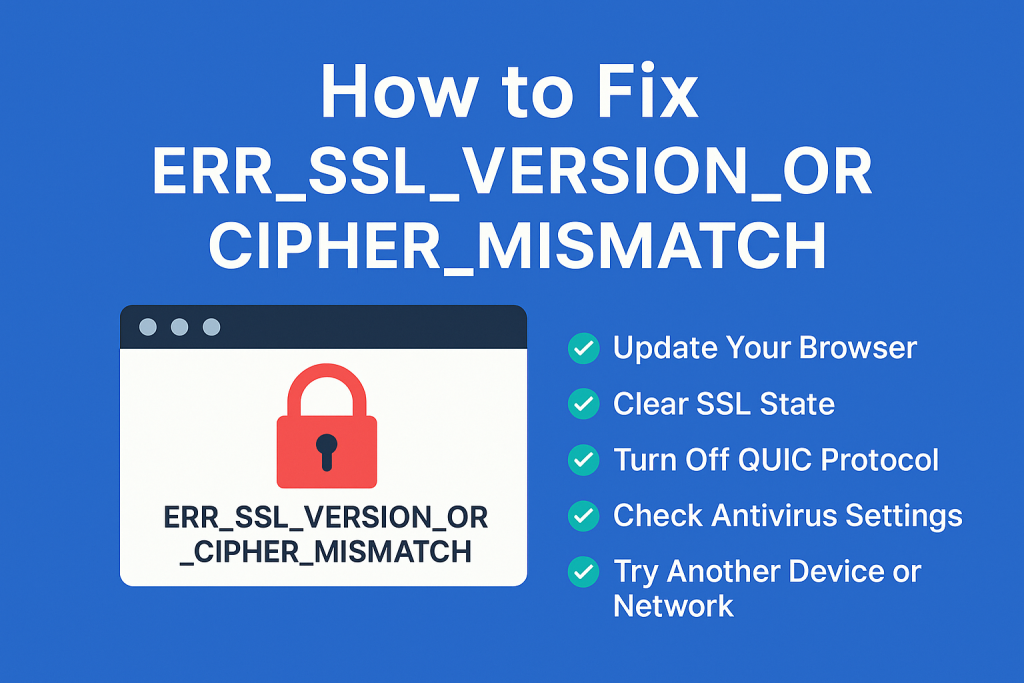The ERR_SSL_VERSION_OR_CIPHER_MISMATCH error often shows up in Chrome or Edge when your browser can’t establish a secure connection to a website. While it may seem like a serious security problem, the good news is: it’s usually easy to fix.
🧑💻 Part 1: If You’re Just Visiting a Website
✅ 1. Update Your Browser to the Latest Version
Why: Older versions of browsers might not support the latest TLS protocols or may block deprecated ciphers.
How to do it (Chrome example):
-
Open Chrome.
-
Click the three-dot menu > Help > About Google Chrome.
-
Chrome will check for updates automatically and install them.
-
Restart the browser.
➡️ Try accessing the website again after the update.
✅ 2. Clear Your SSL State in Windows
Why: SSL cache stores certificate data. If that data is outdated or corrupted, it may prevent new connections.
How:
-
Press
Windows + R→ typeinetcpl.cpl→ press Enter. -
The Internet Properties window will open.
-
Go to the Content tab.
-
Click on Clear SSL State.
-
Click OK, then restart your browser.
This step is simple but often overlooked—and surprisingly effective.
✅ 3. Turn Off QUIC Protocol in Chrome
Why: The QUIC protocol is an experimental transport layer network protocol developed by Google. It can sometimes interfere with SSL handshakes.
Steps:
-
Open Chrome.
-
Type
chrome://flags/#enable-quicin the address bar. -
Find Experimental QUIC Protocol and set it to Disabled.
-
Restart Chrome.
If the error goes away after disabling this, you’ve found your culprit.
✅ 4. Check Antivirus and Firewall Settings
Why: Some antivirus software (like Avast, AVG, Bitdefender) includes an HTTPS scanning feature that can block websites using uncommon SSL settings.
Fix:
-
Open your antivirus program.
-
Look for settings related to “Web Shield”, “HTTPS Scanning”, or “SSL Inspection”.
-
Temporarily disable these options.
-
Try accessing the website again.
🛡 Important: If it works, consider disabling only that feature permanently—or switch to a more compatible security suite.
✅ 5. Test on Another Browser, Device, or Network
Why: The issue might not be the website or SSL at all—it could be something on your device, browser profile, or local network.
Try:
-
Open the same URL on a different browser (e.g., Firefox or Safari).
-
Use another device (e.g., your phone) on the same network.
-
Connect to a different network (like a mobile hotspot).
If the site loads fine elsewhere, then the issue lies with your original setup.
🧑🔧 Part 2: If You’re a Website Owner or Admin
✅ 1. Use an SSL Test Tool to Identify the Issue
Recommended Tools:
What to look for:
-
Is the certificate expired?
-
Are TLS 1.0 or 1.1 still enabled?
-
Are weak ciphers like RC4 or NULL included?
-
Is your site serving a mismatch of www and non-www?
📌 These tools give you a full breakdown of what browsers see when connecting to your site.
✅ 2. Disable Deprecated Protocols (SSLv3, TLS 1.0, 1.1)
Why: Modern browsers no longer support these protocols due to security vulnerabilities.
# Apache
SSLProtocol All -SSLv2 -SSLv3 -TLSv1 -TLSv1.1
# Nginx
ssl_protocols TLSv1.2 TLSv1.3;➡️ Save your changes and restart Apache/Nginx.
✅ 3. Use a Strong Cipher Suite
Why: Weak ciphers like RC4, NULL, or anonymous ciphers can trigger browser rejection.
# Apache
SSLCipherSuite HIGH:!aNULL:!MD5:!RC4
SSLHonorCipherOrder on
# Nginx
ssl_ciphers 'ECDHE-ECDSA-AES256-GCM-SHA384:ECDHE-RSA-AES256-GCM-SHA384';
ssl_prefer_server_ciphers on;✅ 4. Check for Mismatched SSL Certificate
If your domain is www.example.com but the SSL certificate is for example.com (no www), the browser may reject it.
Fix:
-
Use a wildcard certificate (
*.example.com) or -
Ensure both
wwwand root domain are covered in the SAN (Subject Alternative Name)
Check this via the certificate details panel in your browser or the SSL Labs test.
✅ 5. Remove or Avoid RC4 Ciphers
Why: RC4 was once common, but now is insecure and blocked by all major browsers.
What to do:
-
Check your cipher suite config (as above).
-
Make sure RC4 is removed.
✅ 6. Be Careful with HSTS (Strict-Transport-Security)
What is it?
HSTS forces browsers to always load your site using HTTPS—even if the certificate is broken.
If misconfigured:
-
Visitors may be locked out completely.
How to handle:
-
Only enable HSTS after confirming your SSL setup is 100% valid and includes all necessary subdomains.
👨🏫 Summary Table
| For Users | For Site Owners |
|---|---|
| ✔ Update browser | ✔ Check SSL cert validity |
| ✔ Clear SSL state | ✔ Use TLS 1.2/1.3 only |
| ✔ Disable QUIC | ✔ Remove weak ciphers |
| ✔ Check antivirus | ✔ Fix domain mismatches |
| ✔ Try other device/network | ✔ Test with SSL Labs |
🚀 Final Tip
Sometimes, just waiting a few minutes helps—especially if SSL settings were recently changed. Certificate propagation might take time.
Still stuck? Drop a comment with your browser/server stack and we’ll help you debug it!


